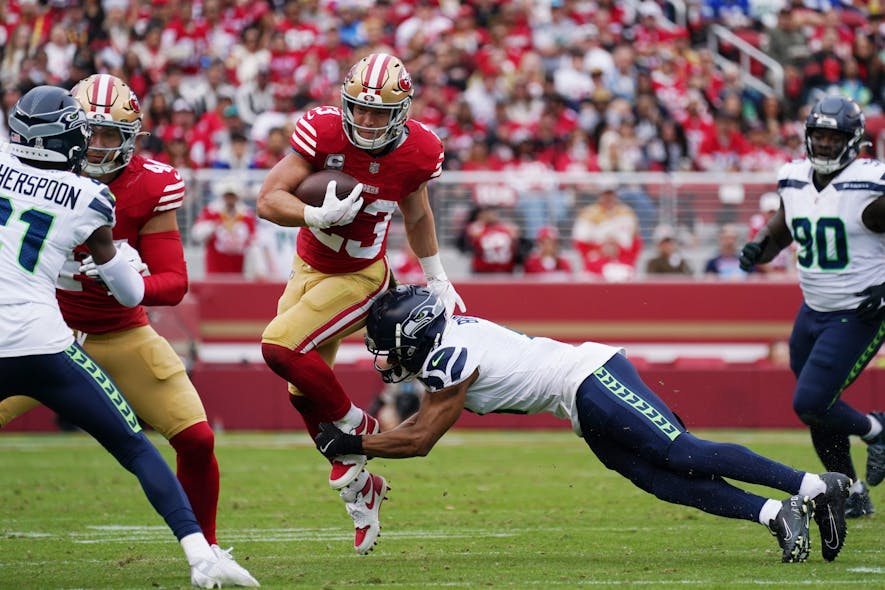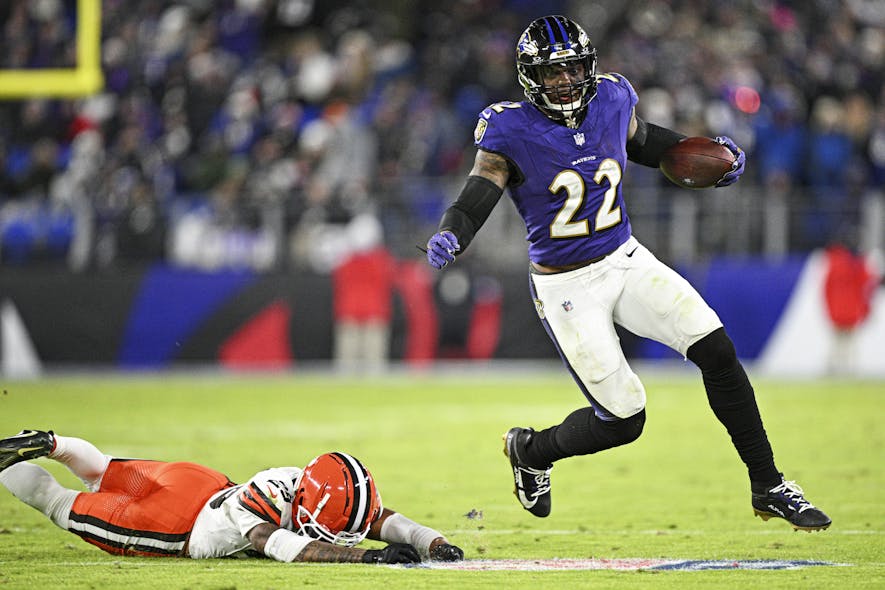The NFL has shifted. Less frequently do offenses rely on one running back to shoulder the offensive load. The bell cow is still around, sure. The Saquon Barkleys, Christian McCaffreys, and Kyren Williamses of the world might be endangered, but they aren't extinct.
These snap hogs carry risk. Volume builds up in a league this brutal, especially over time. The development isn't new. It just seems teams are more sensitive to the reality in today's game. It's likely why teams have elected to lean on multiple players to split the responsibility.
When I started playing fantasy football, there was nothing worse than a vulture. I'm almost certain that's still thrown around from time to time. In the case that the vernacular has evolved, a back who steals any sort of valuable touch is colloquially known as a vulture. A thief who takes the fantasy points that your RB1 rightfully earned. They were the bane of your existence. Mike Tolbert might be one of the greatest vultures to ever play. I'm sure other names flood to mind depending on your unique experience.
Vultures have evolved, though. The bird that used to circle and feed on goal-line carries now gets a much more balanced diet. They aren't eating scraps; they're getting their own plate.
The impression seems to be that committees are inherently bad for the primary option. That very well could be the case, but I wanted to attempt to find a concrete answer. I had a slightly different theory I wanted to hold to scrutiny. The conclusion could be the difference in the way I value players.
I'm bringing you along for the ride. Here's what we'll be testing.
Hypothesis
Bell cows are more frequently RB1s on a per-game basis, while committee leaders still produce RB1-level finishes on an overall points basis.
First, some clarifications: I want to determine if longevity is a product of committee play and can lead to RB1-level point totals for backs with the largest snap share. Inversely, I'm looking at the value disparity between the bell cows and the committee leaders since 2021.
Disclaimer: These point figures are calculated based on production from Weeks 1-18.
I'll be examining seasons since 2021, and the RB1/RB2 thresholds are calculated using the average ranges of the RB1-12 and RB13-24 in Half-PPR scoring across those four seasons. I'd like to go back further, but I'm concerned the shift from 16 games to 17 will distort the validity of the numbers. Therefore, we're using the last four seasons as our sample size.
Average Half-PPR RB1 (RB1-RB12) Range Since 2021:
- PPG: 21.2-14.1
- Total: 341.8-210.1
Average Half-PPR RB2 (RB13-RB24) Range Since 2021:
- PPG: 13.6-11.2
- Total: 206.9-167.2
The ranges are interesting. There's a 7.1-point chasm between the PPG RB1 and RB12, then a 131.7-point gap in total points. My primary takeaway is that very few RB1s have an RB1-overall ceiling. An infinitesimal group of players have the potential to score 341.8 Half-PPR points in a season.
The range shrinks for RB2s. 2.4 points per game separated the RB13-RB24. The total difference was only 39.7 points. In other words, there has been no significant difference between rostering RB13 and RB24 since 2021.
You can also infer any number that lands between the two ranges -- 13.8 PPG, for example, could go either way depending on the season. I'll call those players swing players, for the sake of the rates we'll look at later.
Let's look at the criteria I'll use to define bell cows versus backs who lead committees. We'll call it the Gibbs Split, after the player who sparked this curiosity.
- Bell Cows
- 15+ games played
- 67+ percent of their team's offensive snaps per game
- Committee Leaders
- 16+ games played
- 66.9-50 percent of their team's offensive snaps per game
Let's start with the bell cows. That's probably who you're after in drafts anyway.
The Bell Cows
Since 2021, 19 backs have handled at least 67 percent of their team's snaps per game across at least 15 games. That equates to roughly 4.8 backs each year who meet this standard. From 2017 to 2020, the last four seasons of the 16-game era, 27 backs handled the same snap share across 14 games. That was good for approximately 6.8 backs on average each season. In other words, we see two fewer bell cow running backs each season who meet this criteria.
It's a noticeable dip over the four-year sample. It's important to note, though, that six backs in both 2023 and 2024 met the criteria, up from five in 2022 and just two in 2021. Let's now answer an important question: How does this translate to fantasy production over the last four years?
Average Bell Cow Season Since 2021 (Weeks 1-18)
| Games Played | Offensive Snap Percentage | Half-PPR Total Points | Half-PPR PPG | Average Age | PPG RB1 or RB2 | Total RB1 or RB2 |
|---|---|---|---|---|---|---|
| 16.5 | 74.5 | 258.3 | 15.7 | 24.8 | RB1 | RB1 |
On average, a running back who was deployed as a bell cow over the last four years averaged 1.7 half-PPR points per game more than the average RB2 since 2021. The total points figure was comfortably in the RB1 tier, which is a product of the fact that these players have played in almost all of their team's games. The players who comprise this tier might provide some context for the PPG figure.
Bell Cow Running Backs Since 2021
| Team | Player | Half-PPR Total Points | Half-PPR PPG | Age | Snap%/G | G | Season |
|---|---|---|---|---|---|---|---|
| SF | Christian McCaffrey | 357.8 | 22.4 | 27 | 80.8 | 16 | 2023 |
| Ind | Jonathan Taylor | 353.1 | 20.8 | 22 | 68.9 | 17 | 2021 |
| Phi | Saquon Barkley | 338.8 | 21.2 | 27 | 73.6 | 16 | 2024 |
| Car/SF | Christian McCaffrey | 313.9 | 18.5 | 26 | 73.3 | 17 | 2022 |
| Atl | Bijan Robinson | 311.2 | 18.3 | 22 | 75.3 | 17 | 2024 |
| LV | Josh Jacobs | 301.8 | 17.8 | 24 | 74.5 | 17 | 2022 |
| Pit | Najee Harris | 263.7 | 15.5 | 23 | 83.5 | 17 | 2021 |
| NYG | Saquon Barkley | 255.5 | 16.0 | 25 | 79.9 | 16 | 2022 |
| LAR | Kyren Williams | 255.1 | 15.9 | 24 | 86.7 | 16 | 2024 |
| Jax | Travis Etienne Jr. | 253.4 | 14.9 | 24 | 73.4 | 17 | 2023 |
| Cin | Joe Mixon | 241.0 | 14.2 | 27 | 69.1 | 17 | 2023 |
| TB | Rachaad White | 235.9 | 13.9 | 24 | 78.1 | 17 | 2023 |
| Car | Chuba Hubbard | 220.1 | 14.7 | 25 | 77.4 | 15 | 2024 |
| Min | Dalvin Cook | 218.3 | 12.8 | 27 | 72.0 | 17 | 2022 |
| Atl | Bijan Robinson | 217.3 | 12.8 | 21 | 68.2 | 17 | 2023 |
| NYJ | Breece Hall | 212.4 | 13.3 | 23 | 72.1 | 16 | 2024 |
| Dal | Tony Pollard | 195.1 | 11.5 | 26 | 70.6 | 17 | 2023 |
| NO | Alvin Kamara | 183.2 | 12.2 | 27 | 69.5 | 15 | 2022 |
| Ten | Tony Pollard | 180.2 | 11.3 | 27 | 68.4 | 16 | 2024 |
| Average Season | 258.3 | 15.7 | 24.8 | 74.5 | 16.5 | ||
While the average of games from a bell cow back meets the RB1 threshold outlined above, it's also worth noting that 36.9 percent of the players who maintained the role in their respective offense didn't meet the 14.1 fantasy-points-per-game cutoff. That left them in the RB2 tier. The average positional half-PPR draft position for the listed players was RB11.
There are certainly late-round steals. Of the 19 players, four had positional ADPs beyond 20. On average, it costs a premium pick to land a bell cow. Go figure. The average return on the investment is 15.7 Half-PPR fantasy points per game since 2021.
Six players have handled a 67 percent snap share and surpassed 300 fantasy points since 2021. They've combined to average +0.03 EPA/Att. These are the unicorns. Over the past four seasons, you're lucky to see one running back produce a season in which they're efficient with massive rushing volume and handle at least 67 percent of their team's offensive snaps. Two running backs - Saquon Barkley and Bijan Robinson - did it last year. Christian McCaffrey's done it twice in the last four years. 2021 Jonathan Taylor and 2022 Josh Jacobs are the other two members of the club.
The 13 bell cows after the six who totaled 300 Half-PPR points averaged 13.8 points per game. That's a swing number. These players have been in the RB12-to-RB13 since 2021.
The track record for staying on the field was interesting. The 19 bell cows averaged 16.5 games per season. To appraise the validity of the durability, I wanted to see how many backs handled at least 67 percent of their team's snaps per game from 2021 to 2024 and missed the 15-game mark.
Thirteen backs over that span met the snap share requirement, but played in 14 or fewer games. That means 59 percent of the backs who handled 67 percent of their team's offensive snaps since 2021 made it through at least 15 games.
Also, keep in mind that the average age of the bell cows was 24.8 years old.
Let's Recap
Efficient bell cows are rare.
The RB1 production for everyone else in the tier is modest on a per-game basis. Those players played in 15+ games at a 59 percent clip and will hang around in total points. The players who held up with the workload were young. Don't just assume a player will return value relative to their draft slot because of their usage.
The Committee Leaders and Derrick Henry
This tier is going to be significantly bigger than the bell cows. It's also where I believe the most impactful data rests and will serve as yet another indication of how absurd Derrick Henry is.
Let's start with the averages for this subset of players. Again, we're looking at running backs who handled 66.9-50 percent of their team's snaps and played in 16 games.



